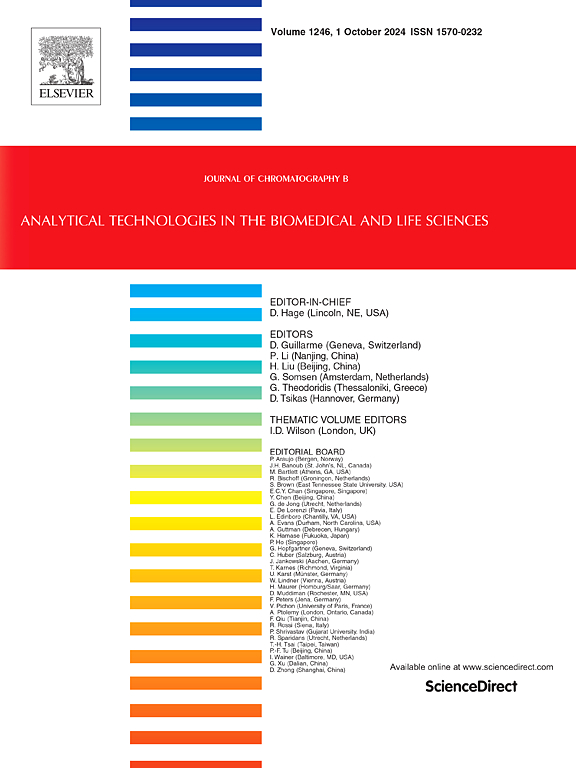阿库玛生物碱的综合药代动力学及ADME评价
IF 2.8
3区 医学
Q2 BIOCHEMICAL RESEARCH METHODS
引用次数: 0
摘要
阿库玛树(Picralima nitida)的种子传统上被用来治疗发烧和疼痛。该种子含有至少五种主要生物碱:阿库米明、阿库米明、阿库米明、picraline和伪阿库米明,具有多种药理作用,包括镇痛、抗炎和改善情绪的特性。本研究旨在利用超高效液相色谱-串联质谱(UPLC-MS/MS)的生物分析方法,研究川麻生物碱的体内体外药动学。该方法简便、灵敏、快速,可有效评价雄性Sprague-Dawley大鼠体内的吸收、分布、代谢和口服/静脉药代动力学。这些生物碱在人结直肠癌细胞单层中表现出高通透性。在还原性烟酰胺腺嘌呤二核苷酸磷酸补充的大鼠肝微粒体中,阿库胺和阿库胺的半衰期分别为13.5和30.3 min。伪阿库米明与血浆蛋白结合程度最高,其他生物碱次之。口服磨碎种子悬浮液的剂量显示只有阿库胺的显著全身暴露,口服生物利用度低。本研究是首个关于阿库玛生物碱ADME特性和药代动力学的综合报告,为开发这些化合物作为潜在的植物治疗药物用于疼痛管理或其他药物用途提供了重要见解。本文章由计算机程序翻译,如有差异,请以英文原文为准。
Comprehensive pharmacokinetics and ADME evaluation of Akuamma alkaloids
The seeds of the akuamma tree (Picralima nitida) have been traditionally used to treat fever and pain. The seed contains at least five major alkaloids: akuammine, akuammicine, akuammiline, picraline, and pseudo-akuammigine, which possess diverse pharmacological effects, including analgesic, anti-inflammatory, and mood-enhancing properties. The present study aimed to assess in vitro and in vivo pharmacokinetics of akuamma alkaloids using a sensitive ultra-performance liquid chromatography−tandem mass spectrometry (UPLC-MS/MS)-based bioanalytical method. The method was found to be simple, sensitive, and rapid, effectively evaluating absorption, distribution, metabolism, and oral/intravenous pharmacokinetics in male Sprague-Dawley rats. These alkaloids demonstrated high permeability using human colorectal adenocarcinoma cell monolayers. Akuammine and akuammiline showed half-lives of 13.5 and 30.3 min in reduced nicotinamide adenine dinucleotide phosphate-supplemented rat liver microsomes. Pseudo-akuammigine showed the highest plasma protein binding, followed by the other alkaloids. Oral dosing of the ground seed suspension revealed significant systemic exposure of only akuammine, with low oral bioavailability. This research is the first comprehensive report on the ADME properties and pharmacokinetics of akuamma alkaloids, providing critical insights for developing these compounds as potential phytotherapeutic agents for pain management or other medicinal uses.
求助全文
通过发布文献求助,成功后即可免费获取论文全文。
去求助
来源期刊

Journal of Chromatography B
医学-分析化学
CiteScore
5.60
自引率
3.30%
发文量
306
审稿时长
44 days
期刊介绍:
The Journal of Chromatography B publishes papers on developments in separation science relevant to biology and biomedical research including both fundamental advances and applications. Analytical techniques which may be considered include the various facets of chromatography, electrophoresis and related methods, affinity and immunoaffinity-based methodologies, hyphenated and other multi-dimensional techniques, and microanalytical approaches. The journal also considers articles reporting developments in sample preparation, detection techniques including mass spectrometry, and data handling and analysis.
Developments related to preparative separations for the isolation and purification of components of biological systems may be published, including chromatographic and electrophoretic methods, affinity separations, field flow fractionation and other preparative approaches.
Applications to the analysis of biological systems and samples will be considered when the analytical science contains a significant element of novelty, e.g. a new approach to the separation of a compound, novel combination of analytical techniques, or significantly improved analytical performance.
 求助内容:
求助内容: 应助结果提醒方式:
应助结果提醒方式:


